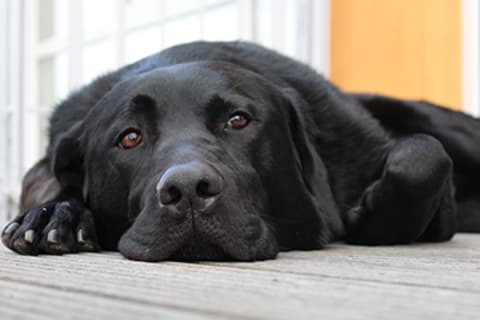What is the ACL or CCL?
The anterior cruciate ligament (ACL) is a thin connective tissue in the middle of a human's knee.
In dogs this connective tissue in is called the cranial cruciate ligament (CCL). The CCL connects the dog's tibia (bone below the knee) to their femur (bone above the knee), helping the knee to work properly.
Unlike the ACL in people, the CCL in your dog is always load bearing because a dog's hind knee is always bent when they are standing.
Differences Between Injuries to CCL vs ACL
ACL injuries in people are particularly common in athletes such as basketball and football players. ACL injuries typically occur due to an acute trauma stemming from a sudden movement such as a change of direction or a jump.
In dogs however, CCL injuries tend to come on gradually and become progressively worse with continued activity until a painful tear occurs.
While these injuries are different, since most of us are familiar with the term ACL we frequently refer to CCL injuries in dogs as ACL injuries.
Signs & Symptoms of ACL Injuries in Dogs
The most common signs of a CCL injuries in dogs are:
- Hind leg lameness and limping
- Stiffness (typically most noticeable after rest, following exercise)
- Difficulty rising and jumping
- Swelling on the inside of the knee
If the dog continues to exercise on a mildly injured CCL the injury will gradually become worse and the symptoms will become more pronounced.
Dogs suffering from a single torn CCL will begin favoring the non-injured leg during activity, which will often lead to the second knee becoming injured also. It is estimated that about 60% of dogs with a single CCL injury will go on to injure the other knee.
CCL injuries can occur in dogs of any size but are particularly common in larger breeds such as Bernese Mountain dogs, German Shepherds, Golden Retrievers, Rottweilers, Labs, and American Bulldogs.
Treatment for ACL Injuries in Dogs
If your dog has been diagnosed with a CCL injury, there are a number of treatment options available. The best treatment for your dog will be determined by the severity of the injury, your dog's age, size, and weight as well as your dog's lifestyle and energy level. Your vet may recommend one of the following treatments.
- Knee Brace -Treating a CCL injury with a knee brace is a non-surgical option that may be able to help to stabilize the knee joint, and give the ligament time to repair itself. When combined with reduced levels of activity, treating CCL injuries through the use a knee brace may be successful in some dogs.
- Extracapsular Repair (Lateral Suture) - This surgical treatment for a CCL injury involves replacing the torn ligament with an artificial ligament on the outside of the joint. This surgery is generally recommended for smaller dogs weighing less than 50lbs.
- Tibial Plateau Leveling Osteotomy (TPLO) - This surgical technique eliminates the need for the cranial cruciate ligament by cutting and flattening the tibial plateau, then stabilizing the knee in the new position with a plate and screws.
- Tibial Tuberosity Advancement (TTA) - TTA surgery also eliminates the need for the CCL by cutting the top of the tibia, moving it forward, and then using a plate to stabilize it in its new position.
Recovery from ACL Surgery
Of course every dog is different, and not all dogs will recover from CCL surgery at the same speed. Recovery from ACL surgery takes time! Following your veterinarian's advice and keeping your dog's activity level at a minimum during their recover will help to speed the process. Expect your dog to require 16 weeks or longer to complete the healing process and return to their normal activity level.
If your dog is showing signs of a torn ACL contact call our Bartlett vets at Hillcrest Animal Hospital today to make an appointment.

Looking for a vet in Memphis?
We're always accepting new patients, so contact our veterinary hospital today to book your pet's first appointment.Related Articles View All
Heimlich Maneuver For Dogs: What To Do If My Dog Is Choking
What should you do if something gets lodged in your dog's throat and they begin to choke? Here, you will find helpful information on the Heimlich maneuver for dogs and what to do if your dog is choking.
Signs That Your Dog May Have a Cavity
Can dogs get cavities? What are the signs of cavities in dogs? In today's post, you will find the answers to these dog cavity questions and more.
Chipped Tooth in Dogs - What to Do if Your Dog Has a Broken Tooth
Dogs often experience chipped or fractured teeth. Is a broken dog tooth an emergency? It might be. Today's post contains information about broken teeth in dogs and what to do about dog tooth fractures.
Large Dog Care & Saving Money with Wellness Plans
What do large and giant breed dogs need to stay healthy and happy? Here, we provide vital information on how to proactively care for your giant or large dog's health and save money along the way.
